Modern Service Industry
Agricultural and Animal Products Cold Chain Logistics Project of Jilin City
1. Introduction to the Project
1.1 Project background
1.1.1 Product introduction
The project relies on the abundant agricultural and animal product resources in Shulan City to build a cold chain logistics center covering an area of 40000 square meters, providing services for the production and circulation of agricultural and aniaml products in Shulan City.
Agricultural and animal products have perishable and seasonal characteristics, and cold chain logistics is crucial for maintaining their quality, reducing losses, and extending shelf life. With the improvement of the industry development environment and the increase in market demand, the demand for cold chain logistics in China will continue to grow in the future.
1.1.2 Market prospect
(1) Analysis of the current situation of the logistics industry
Since China’s official accession to the WTO in 2001, the logistics industry has entered a new stage of development, promoting the globalization of “Made in China”. During the period of the Tenth Five-Year Plan (2001-2005), the policy emphasized the need to quickly establish a socialized and specialized modern logistics service system nationwide that ensures smooth flow of goods, is fast and timely, economically reasonable, and satisfies customers; During the 11th Five-Year Plan (2006-2010), the national level proposed to vigorously promote modern logistics management technology, strengthen the development and utilization of new logistics technologies, promote logistics informatization, and strengthen the integration of logistics infrastructure; the 12th Five-Year Plan (2011-2015) clearly defined the development goals of the logistics industry: the level of informatization, intelligence, and standardization in the logistics industry has been significantly improved, the logistics service capabilities of key industries have been significantly enhanced, and a modern logistics system that is socialized, specialized, and informationized has been initially established. During the 13th Five-Year Plan (2015-2020), China further reduced costs, increase efficiency, and serve the country as a major strategy for the logistics industry, making it a key task for cost reduction, addressing weaknesses, and promoting supply side structural reform, and focusing on promoting innovative development of the logistics industry.
During the 14th Five-Year Plan, according to the 14th Five-Year Plan for the Construction of the Modern Circulation System, accelerating the construction of modern circulation system, making the flow of goods and resources smoother, and improving commercial and logistics facilities have become important tasks for China’s logistics industry during the 14th Five-Year Plan and the industry has entered a stage of high-quality development.
In 2023, the scale of logistics demand reached a new high, with a total social logistics volume of 352.4 trillion yuan, a year-on-year increase of 5.2% calculated at comparable prices. On a quarterly basis, the first quarter, the second quarter, the third quarter, and the fourth quarter saw growth of 3.9%, 5.4%, 4.7%, and 5.4%, respectively, showing a recovery trend of low at first, medium high in the middle, and stable growth finally. The overall growth trend for the whole year is positive.
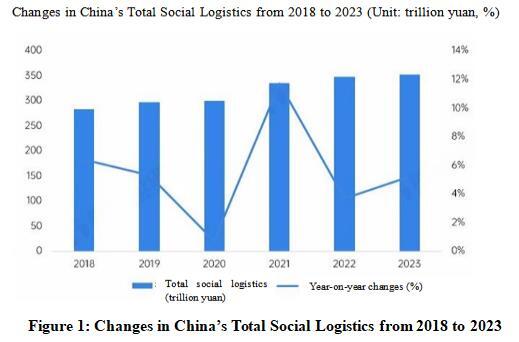
From the composition of the total logistics volume, in 2023, the total logistics volume of industrial products in China exceeded 310 trillion yuan, accounting for over 88%; the next was the total import logistics volume of 18 trillion yuan, accounting for 5.1%; the total amount of logistics in other fields was relatively small.
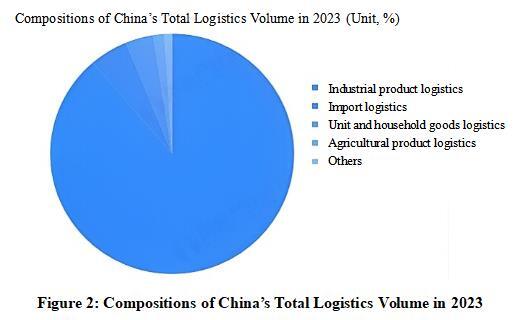
According to data from China Internet of Things, the total revenue of China’s logistics industry has been increasing year by year from 2015 to 2023. The total revenue of the logistics industry for the whole year of 2023 was 13.2 trillion yuan, a year-on-year increase of 3.9%, and the scale of the logistics revenue continues to expand. The year-on-year growth rate of basic logistics revenue such as transportation, warehousing, loading and unloading was around 3%, supporting the stable growth of the logistics market.

The logistics park plays a significant role in economic development, promoting the integration of multiple transportation modes, and improving the urban environment. In recent years, the government and enterprises have unanimously regarded it as a key project to promote regional and urban logistics development, providing strong support.
As of the end of 2023, the National Development and Reform Commission has led the layout and construction of 80 national logistics hubs, covering 29 provinces (regions, cities) and Xinjiang Production and Construction Corps, laying a solid foundation for accelerating the construction of a modern logistics operation system of “channel+hub+network” and supporting the construction of a new development pattern. From the perspective of regional distribution, Guangdong has the highest number of national logistics hubs.
The National logistics Hub Layout and Construction Plan provides top-level design for China’s modern logistics system, planning to build 212 national logistics hubs in 127 host cities across the country, including land port, port, airport, production service, commercial service, and land border port types. Changchun, Jilin, and Yanbian (Hunchun) in Jilin Province are included, and Jilin City has been designated as a national logistics hub for commercial and service-oriented industries. In 2021, Jilin City actively initiated the application and creation work.
(2) Development trends of the logistics industry
According to the 14th Five-Year Plan for the Construction of Modern Circulation System released by the National Development and Reform Commission, it is expected that by 2035, China’s modern circulation system will be fully established, forming a global, safe, reliable, efficient and smooth circulation network. The efficiency and quality of circulation operation will reach the world’s advanced level, and new advantages in participating in international cooperation and competition will be significantly enhanced. This will provide efficient support for the modern economic system and provide solid guarantees for meeting the needs of the people for a better life. In the coming period, the development direction of China’s logistics industry is as follows:
In the future, China will focus on filling the gaps in the modern circulation system, focusing on the high-quality development of the modern circulation system, accelerating the formation of a unified modern circulation market, and developing the two major systems of modern commercial circulation and modern logistics to further improve China’s logistics system. Based on the trend of changes in the total amount and revenue of social logistics in China in recent years, a forecast is made for the total revenue of social logistics in China in the next few years. By the end of 2029, the total revenue of social logistics in China may have reached 17.9 trillion yuan.
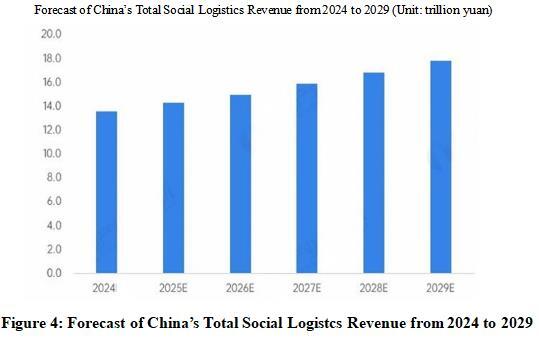
(3) Current situation of the cold chain logistics industry
Cold chain logistics is a professional logistics service that utilizes temperature control, preservation, and other technological processes, as well as facilities and equipment such as cold storage, refrigerated trucks, and refrigerated containers, to ensure that cold chain products are always in a specified temperature environment throughout the entire process of initial processing, storage, transportation, circulation, processing, sales, and distribution. Cold chain logistics, as a fundamental, strategic, and leading industry, is deeply integrated into the high-quality development process of modern agriculture, food processing, medicine and medical industries in China, accelerating the transformation and upgrading of industries, while fully ensuring the daily and emergency supply of“vegetable baskets”, “rice bags”, “fruit plates”, and “meat cases” for people’s livelihood, better meeting the growing demand for a better life of the people.
In recent years, the national level has issued multiple policies related to cold chain logistics, involving multiple departments such as the State Council, the National Development and Reform Commission, the Ministry of Agriculture and Rural Affairs, and the Ministry of Transport, with increasing policy support. For example, the National Development and Reform Commission proposed in the 14th Five-Year Plan for the Development of Cold Chain logistics that by 2025, a cold chain logistics network that connects production and sales areas, covers urban and rural areas, and connects domestic and international markets will have been initially formed, and a cold chain logistics system that is in line with China’s national conditions and industrial structure characteristics, and meets the needs of economic and social development will have been basically established.
With the continuous growth of market demand, support from government policies, continuous improvement of cold chain infrastructure, and driven by technological progress and innovation, the total amount of cold chain logistics in China continues to grow. The Research and Development Prospects Analysis Report on China’s Cold Chain logistics Industry from 2024 to 2029 released by China Academy of Commerce Industry Research shows that the total amount of cold chain logistics in China reached 8.90 trillion yuan in 2023, an increase of 40 billion yuan from 2022 and a year-on-year growth of 4.6%. the total amount of cold chain logistics in China increased to 9.82 trillion yuan by 2024.
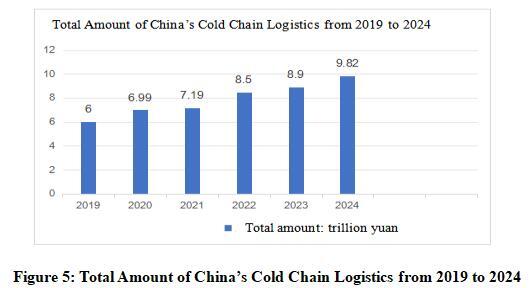
In recent years, the growing demand for people’s daily lives and the development of new formats such as imported cold chain products, fresh e-commerce, community group buying, live streaming e-commerce, and pre-packaged meals have driven the continuous growth of China’s cold chain logistics market. The Research and Development Prospects Analysis Report on China’s Cold Chain logistics Industry from 2024 to 2029 released by China Academy of Commerce Industry Research shows that the scale of China’s cold chain logistics market reached 517 billion yuan in 2023, a year-on-year increase of 5.2%. The size of China’s cold chain logistics market increased to 574.5 billion yuan in 2024.
Cold chain logistics connects the production and consumption ends of modern agriculture, food processing, pharmaceutical products, etc., and is an important support for extending the industrial chain, building the supply chain, and enhancing the value chain. In recent years, with the support of policies and the continuous development of downstream industries, the total demand for cold chain logistics in China has continued to expand. The Research and Development Prospects Analysis Report on China’s Cold Chain logistics Industry from 2024 to 2029 released by China Business Industry Research Institute shows that in 2023, the overall cold chain logistics market in China was under pressure and the demand was gradually stabilizing and recovering. The total demand for cold chain logistics was about 350 million tons, a year-on-year increase of 6.1%. The total demand for cold chain logistics in China reached 387 million tons in 2024.
Cold storage can be regarded as the “base” of cold chain logistics. The construction and development of cold storage has become a top priority for the national backbone cold chain logistics base. The Research and Development Prospects Analysis Report on China’s Cold Chain logistics Industry from 2024 to 2029 released by China Academy of Commerce Industry Research shows that the total amount of cold storage in China was about 228 million cubic meters in 2023, an increase of 18 million cubic meters from the previous year and an increase of 8.3% year-on-year. The total capacity of cold storage in China reached 250 million cubic meters in 2024.
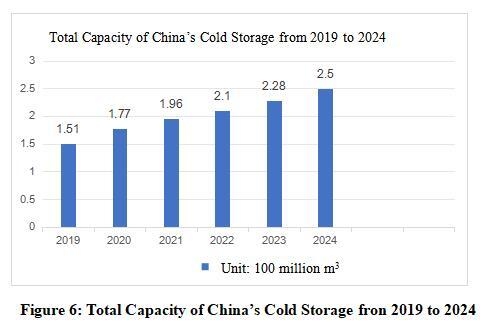
With the increase of policy support, the development prospects of China’s cold chain logistics industry are very broad. In 2024, the No. 1 Document of the Central Committee of the Communist Party of China clearly proposed to promote the transformation and upgrading of agricultural product processing facilities, support the construction of regional pre-cooling and drying, storage and fresh-keeping, fresh cut packaging and other primary processing facilities, and develop intelligent, clean and intensive processing. This demonstrates the high importance and strong support that the country attaches to the development of the cold chain logistics industry. In the 14th Five-Year Plan for the Development of Cold Chain logistics, the country has set the goal of building a cold chain logistics network, requiring the preliminary formation of a cold chain logistics network that connects production and sales areas, covers urban and rural areas, and connects domestic and international markets by 2025. This provides policy support for achieving national and global layout of cold chain logistics.
1.1.3 Technical analysis
By now, the design and refrigeration technology of cold chain logistics have matured, and Jilin Province has a large number of successful cases and professional design teams, which can meet the needs of the project.
1.1.4 Advantageous conditions of project construction
(1) Policy advantages
The Notice on Supporting the Construction of Pilot Cities for Modern Commercial and Trade Circulation System clearly states that we should support the construction and transformation of regional cold chain logistics bases, enhance comprehensive capabilities such as refrigeration, processing, and distribution, connect production, sales, and distribution centers, and connect them with national backbone cold chain material bases, production cold chain preservation equipment, etc., to facilitate the transportation of industrial products to rural areas and agricultural products to urban areas.
The Guiding Opinions on Cultivating Traditional Advantageous Food Production Areas and Local Characteristic Food Industries proposes to strengthen the construction of cold chain logistics facilities for agricultural products such as pre-cooling, storage, and preservation, and fill the gap of the “first kilometer” of food raw materials.
The Ministry of Agriculture and Rural Affairs and the National Rural Revitalization Bureau have issued the Guidelines for Social Capital Investment in Agriculture and Rural Areas (2022), which proposes to “encourage the development of initial processing such as refrigeration and preservation, raw material processing, and graded packaging”, “lay out central kitchens, main food processing, leisure food, convenience food, and clean vegetable processing in the main production areas and suburbs of large and medium-sized cities”, “build a number of storage and preservation, graded packaging, cold chain distribution facilities and equipment, as well as small-scale storage and preservation cold chain facilities in fields”, “encourage places with conditions to build cold chain distribution centers in production areas, create agricultural product logistics nodes, and develop new circulation industries such as supermarkets, agricultural cooperatives, agricultural enterprises, and agricultural schools for production and sales docking”, and “encourage the development of new retail of fresh agricultural products. Support cold chain logistics enterprises to grow bigger and stronger.”
The 14th Five-Year Plan for the Development of Modern logistics proposes to “accelerate the integration and construction of logistics hub resources. Support the functional docking and coordinated development of various logistics centers, distribution facilities, professional markets, etc. with national logistics hubs, promote the scale aggregation and integrated operation of logistics factors.” “Improve the network of cold chain logistics facilities. Give full play to the resource aggregation advantages of national logistics hubs and national backbone cold chain logistics bases, guide enterprises such as commercial circulation and agricultural product processing to gather at hubs and bases or strengthen collaborative connections. Strengthen the construction of production and sales cold chain logistics centers, improve the efficiency of post-production distribution and commercialization processing of agricultural products in production areas, and improve the cold chain logistics system in sales cities.”
The Ministry of Agriculture and Rural Affairs, together with the National Development and Reform Commission, the Ministry of Finance, and the Ministry of Natural Resources, has formulated and issued the National Plan for the Construction of Modern Facility Agriculture (2023-2030), which specifies four key tasks, including the construction of modern logistics facilities mainly for storage, preservation, and drying.
The General Office of the Ministry of Agriculture and Rural Affairs has issued a notice on continuing to do a good job in the construction of refrigeration and preservation facilities in agricultural product production areas, focusing on deploying and improving the network of refrigeration and preservation facilities in production areas, promoting the sinking of cold chain logistics service networks to rural areas, cultivating a group of agricultural product distribution entities in production areas, and innovating a group of agricultural product cold chain logistics operation models to support the construction of refrigeration and preservation facilities in agricultural product production areas.
Nine departments including the Central Finance Office, the Central Agricultural Office, the Ministry of Commerce, the Ministry of Agriculture and Rural Affairs, the National Development and Reform Commission, the Ministry of Finance, the Ministry of Transport, the State Administration for Market Regulation, and the State Post Bureau have issued the Guiding Opinions of the Central Finance Office and Other Departments on Promoting High-quality Development of Rural Circulation. The guiding opinions proposes strengthening the construction of agricultural product storage and preservation cold chain facilities, accelerating the filling of the shortcomings of county and rural logistics facilities, reasonably optimizing the layout of commercial and trade circulation facilities, promoting deep integration of urban and rural circulation, strengthening digital empowerment of rural circulation, cultivating leading enterprises in rural circulation, improving the standard system of rural circulation, and strengthening market supervision in the rural circulation field. Key tasks include improving relevant financial and tax support policies, and enhancing land and talent support, and it is required to make the construction of modern rural circulation system an important part of the five-level secretaries’ efforts to promote rural revitalization, and to strengthen organizational implementation.
The 14th Five-Year Plan for the Development of Service Industry in Jilin Province points out the need to promote the agglomeration development of service industry in city level central cities. Based on local resources, industrial advantages, and urban development, the 8 regional central cities, that is, Jilin, Siping, Liaoyuan, Yanbian, and Changbai Mountain Management Committee integrate service industry resources, optimize service industry development space, and vigorously cultivate and construct various service industry clusters and parks such as commercial logistics, tourism and leisure, cultural education, health and wellness, financial commerce, research and development, and advertising creativity.
The Investment Promotion Policy of Jilin City clearly states that the investment projects of Jilin City’s Industrial Investment Guidance Fund should comply with national and relevant industrial policies and development plans, with a focus on investing in tourism, medicine and health, aviation, information technology, new materials, advanced equipment manufacturing, biotechnology, energy conservation and environmental protection, new energy, cultural creativity, modern agriculture, modern service industry and other related industries in Jilin City’s “6411” industrial plan, as well as other areas supported by the municipal government for development.
(2) Resource advantages
Shulan City is located in the northeast of Jilin Province, in the transitional zone from the Changbai Mountains to the Songnen Plain. It is situated on the world’s golden corn and rice planting belts, with a perennial crop planting area of 2.16 million mu, making it a major grain producing county; The planting area of traditional Chinese medicine in the city is about 2500 hectares, with a yield of about 3000 tons.
Shulan City is striving to build a nationally representative and influential “Rice City”, “Molybdenum City”, “Goose City”, “Ginseng City”, “Pet Food City”, and “Prefabricated Vegetable City” through four characteristic industrial clusters: deep processing of agricultural products and fine processing of food, development of mineral resources, equipment manufacturing, and new energy and new materials. Shulan City aims for “green, ecological, efficient, and standardized” development, adheres to institutional and mechanism innovation, solidly promotes green agricultural development, and promotes green agricultural products represented by “Shulan rice” to the whole country, driving the high-quality development of agriculture in the city.
(3) Talent advantages
Jilin City has a large number of high-quality and mature technical workers. After training by enterprises and public welfare institutions, more than 10000 skilled talents are sent to the society every year, and more than 20000 people of various types are trained for the society. The labor resource advantages are obvious, and the proportion of skilled workers is at a high level in the Northeast urban agglomeration. The labor force is in a dividend period, and the labor cost is relatively low, which can meet the needs of various enterprises.
(4) Location and transportation advantages
Shulan City is located at the intersection of two provinces and three cities, in the central area of the Northeast Asian economic circle, in the hinterland of China Changchun-Jilin-Tumen Development and Opening Pilot Zone. It borders Jilin City to the south, Harbin City to the north, and faces Changchun City across the Songhua River to the west. It is within the one hour economic circle of Jilin, Changchun, and Harbin. The transportation within the territory is convenient, with a well connected network of public and railway transportation. There are 8 high-grade trunk highways at the national, provincial, and municipal levels, and three railways, namely, Lafa-Harbin, Jilin-Shulan, and Shulan-Yushu, run through the territory. During the 14th Five-Year Plan, the Baiqi Songhua River Bridge steadily advanced, and the location advantages of Shulan City, located at the node of “two provinces and three cities”, were further highlighted.
1.2 Contents and scale of project construction
The project covers an area of 40000 square meters, with a total construction area of 40000 square meters. The main building contents include the construction of 1 cold chain transportation vehicle transfer center, 1 cold storage, 1 turnover warehouse, 1 temporary storage warehouse and other buildings, as well as the purchase of cold storage information equipment.
1.3 Total investment of the project and capital raising
1.3.1 Total investment of the project
The total investment of the project is 200 million yuan, including the construction investment of 162 million yuan and current funds of 38 million yuan.
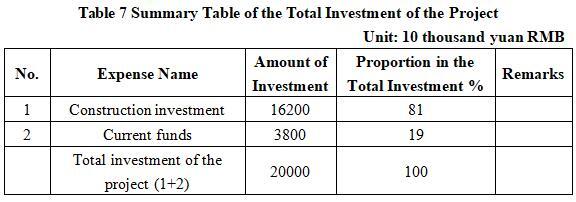
1.3.2 Capital raising
Self-raising by the enterprise
1.4 Financial analysis and social evaluation
1.4.1 Main financial indexes
After the project reaches the production capacity, its annual sales revenue will be 294.11 million yuan, its profit will be 36.76 million yuan, its investment payback period will be 7.8 years (after the tax, including the construction period of 1 year) and its return on investment will be 18.4%.
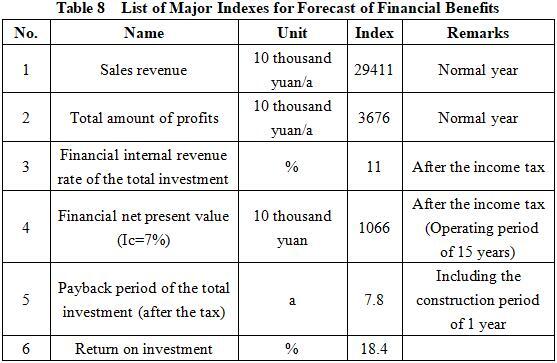
Note: “10 thousand yuan” in the table is in RMB.
1.4.2 Social evaluation
The project promotes the cross regional circulation of agricultural products, enabling them to enter the market more quickly and widely. This helps optimize the agricultural industry structure, enhance the market competitiveness of agricultural products, and promote the upgrading and development of the agricultural industry. At the same time, cold chain logistics projects can also drive the development of surrounding service and commercial industries, form industrial cluster effects, and promote the overall prosperity of the local economy.
1.5 Cooperative way
Joint venture or cooperation, other methods can be discussed face-to-face.
1.6 What to be invested by the foreign party
Funds, and other methods can be discussed face-to-face.
1.7 Construction site of the project
Shulan City, Jilin City
1.8 Progress of the project
It is attracting foreign investment.
2. Introduction to the Partner
2.1 Basic information
Name: Shulan Economic and Technological Cooperation Center
Address: Shulan City, Jilin City
2.2 Overview
Shulan is located in the northeast of Jilin Province, in the “World Golden Rice Belt”, “World Golden Corn Belt”, and “Ice and Snow Golden Latitude Belt” at 440 north latitude. It has a total population of 587000 and governs 10 towns, 5 townships, 5 streets, and 1 provincial-level development zone. It enjoys the reputation of “hometown of tribute rice” and “city of fruits”. Relying on its strong resource advantages and industrial foundation, Shulan City currently has five advantageous industries: equipment manufacturing, pharmaceutical and health product production, deep processing of agricultural products, clean energy, and mineral resource development. There are 53 industrial enterprises above designated scale, forming four industrial clusters: mineral resource development, deep processing of agricultural products, equipment manufacturing, and new energy and new materials. At the Fourth Plenary Session of the 15th Shulan Municipal Committee of the Communist Party of China, it was proposed to “accurately grasp the strategic task of promoting high-quality development, carry out the breakthrough year action for industrial transformation, accelerate the construction of a modern industrial system, and create a “3+4” industrial system. ‘3’ means to focus on improving the industrialization and chain development level of the three landmark industries of white goose, molybdenum, and rice; ‘4’ refers to expanding and strengthening the four advantageous industrial clusters of agricultural products and their deep processing, food precision processing, mineral resource development, equipment manufacturing, and new energy and new materials, cultivating large industries, and building large clusters.”
2.3 Contact method
Postal code: 132000
Contact person: Miao Yuhang
Tel: +86-432-68200065 +86-15143985789
E-mail: slsjhzx@163.com
Contact method of the city (prefecture) where the project is located:
Contact unit: Investment Promotion Service Center of Jilin Bureau of Commerce
Contact person: Jiang Yuxiu
Tel: +86-432-62049694
+86-15804325460
E-mail: jlstzcjfwzx@163.com


